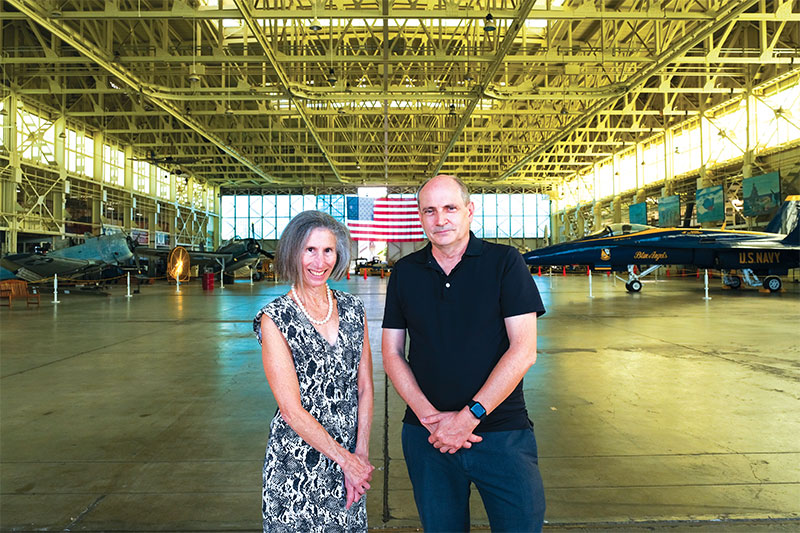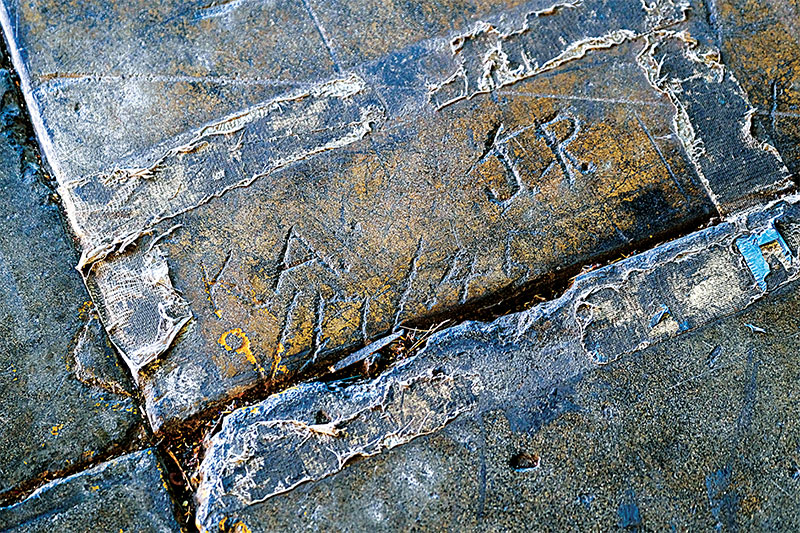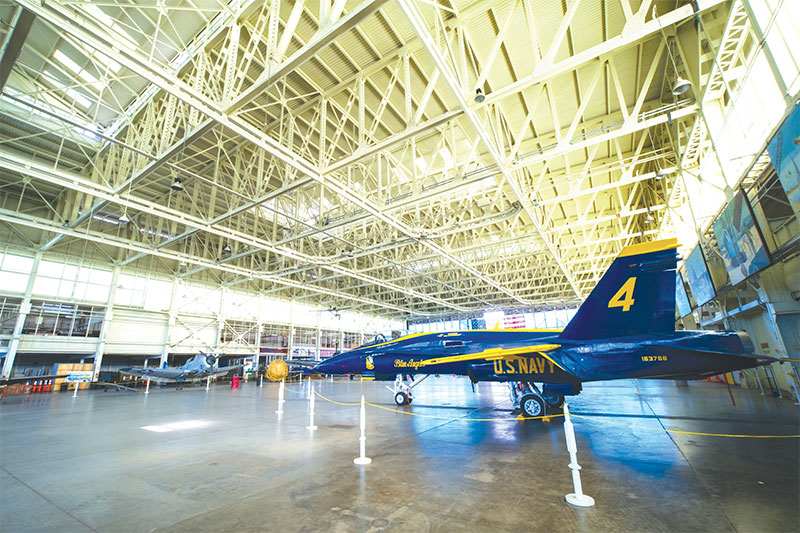Repairs Take Flight

Pearl Harbor Aviation Museum executive director Elissa Lines and Rodney Bengston, director of exhibits, restoration and curatorial services, stand within the Hangar 79 facility.
Now that the fundraising campaign “Raise the Roof” is off and soaring, Pearl Harbor Aviation Museum and its staffers can eagerly look forward to the day when Hangar 79 is restored to its former glory.
Hangar 79 on the grounds of Pearl Harbor Aviation Museum has stood the test of time. Once a WWII maintenance and engine repair facility, it continues to rehabilitate planes as home to the The Shealy Restoration Shop, which refurbishes authentic aircraft from past wars, including the legendary B-17E Swamp Ghost (see story on page 13).
“The hangar is one of the still-standing structures that was here on Dec. 7, 1941,” explains Rodney Bengston, director of exhibits, restoration and curatorial services.
The two large hangar doors are still functioning and run the length of the building, and the interior crane system remains operational, too. History literally lives within the walls of Hangar 79, and those who take a closer look at some of the concrete walls and wooden posts might notice sailors’ notations on when repairs were made, local numbers for ambulances and emergency personnel, and more.
“It’s an interesting structure and historically significant as an artifact because it’s pretty much intact and still functioning,” Bengston adds.
But functionality doesn’t equate to being in tip-top shape, so Pearl Harbor Aviation Museum is currently running a fundraising campaign to “Raise the Roof” for Hangar 79, which is in need of repairs.
“Just standing in front of Hangar 79 and its immensity is overwhelming,” says executive director Elissa Lines. “You can understand why from a historic perspective we need to take care of it. It’s a part of our history.”
The nonprofit museum was awarded a $1 million challenge grant from an anonymous donor, who offered a dollar-for-dollar match. Total costs will be upward of $4 million for the entirety of the roof, with $2 million allotted to address the most pressing issue: keep the elements out, thus protecting both the planes and the people who walk through the 86,000-square-foot hangar.
“There are other things we want to do for this hangar to make it usable, and that will allow us to open the facility completely to the public and begin putting up some displays,” says Lines.
While repairs are taking place, Hangar 79 will have only a handful of aircraft within its walls —though, normally it houses up to 20 — freeing up space to prepare for the first phase of the restoration process, which kicked off Jan. 18. But, Lines notes, visitors can still see the planes, which will be displayed outside with informational placards, and can still be carefully guided within the hangar.
“Visitors will not miss seeing our historic aircrafts,” she assures.
Phase 1 of repairs will shore up the original upper monitors and skylights. These provide natural light and cooling effects, while keeping rain and critters out — all without using electricity. Lines expects those upgrades to take six to eight weeks.
Phase 2 will restore the set of 31 skylights on the mezzanine level and fix the gutter flashings. Once those two steps are done, “we can start building exhibits inside,” Lines adds with excitement.

Soldiers working in Hangar 79 during WWII carved memos, like “K.A. J.R. 9/17/41,” into the concrete.
And both Lines and Bengston are happy to note that “Raise the Roof” fund-raising efforts will do so much more than simply provide ceiling repairs.
Aside from housing history’s iconic wartime planes, Hangar 79 has also entrenched itself as part of the community. For years, the spacious facility has been used for events, including Pearl Harbor Aviation Museum’s annual For Love of Country Gala, showcasing movies on a big screen, and hosting public programs for local students.
“Kids can go through and learn about aviation and history,” Lines says. “We typically ran open cockpit days each year, where we’d open the cockpits and kids could climb and get inside a fighter jet. People probably have memorable experiences inside that hangar. The intergenerational sharing that happens, parents and grandparents can share stories that can tie back to something connected to WWII or the conflict at the time. It’s a multipurpose community facility that allows us to bring people and families together.”
To donate to “Raise the Roof,” visit pearlharboraviationmuseum.org.
A Ghost From The Past, Present

Pearl Harbor Aviation Museum executive director Elissa Lines stands with Swamp Ghost’s nose art, created by Disney animators. The nose art design and the rights were gifted to the museum.
History is filled with stories — some tragic, others heartening — and woven within those tales are pieces of the past that remain a part of society at large.
Swamp Ghost is one of those narratives perpetuated and celebrated at Pearl Harbor Aviation Museum’s Hangar 79. The craft, like the other aviation wonders within structure, tells a story simply by being. A glance over its battle-worn exterior leads one’s imagination to the tragic history that shaped the country and Hawai‘i in particular. This specific Boeing B-17E heavy bomber was supposed to have arrived at Pearl Harbor on Dec. 7, 1941, but mechanical issues kept the craft in California, saving it from the infamous attack. Swamp Ghost eventually embarked on its first regular bombing run in Rabaul in 1942. Under attack from Japanese fighter pilots, the iconic airplane made an emergency landing onto what was thought to be a large wheat field. Instead, it ended up mid-fuselage deep in water and muck. The crew — estimated to be as young as 19 and 20 years old — took light weapons with them and spent weeks crawling through the jungle. And while stories of war are filled with tragedy and heartache, Swamp Ghost’s tale concludes with a happy ending. It’s one wartime account in which the crew survives — recovering from malaria, no less — and each member went on to other units to continue fighting the good fight.
“They demonstrated commitment and grit to get themselves out of a terrible and challenging situation,” says Elissa Lines, executive director of Pearl Harbor Aviation Museum, which houses Swamp Ghost in Hangar 79.
By the end of 1945, the war was over and Swamp Ghost was long forgotten in the South Pacific, yet its positive tale was destined to continue. For decades it sat in the misty Agaiambo Swamp before Australian soldiers stumbled upon it in 1972 during a routine training exercise. Decades later, the craft was resurrected from the mire in the 2006, eventually making its way to Pearl Harbor Aviation Museum in 2012. Just like her crew, Swamp Ghost survived and thrived.
The plane’s short stint in active combat excluded it from receiving a piece of nose art, but as fate would have it, Disney itself created a unique piece of nose art and donated the proprietary piece to Pearl Harbor Aviation Museum.
“Now, it’s only available through our museum,” shares Lines.







